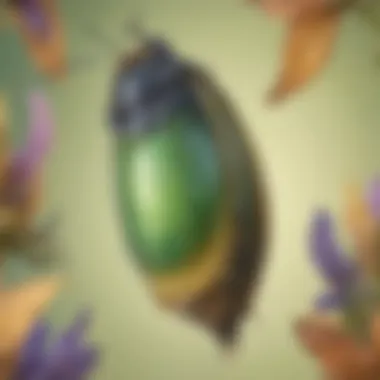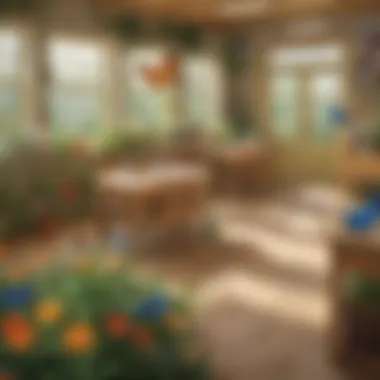Unlocking the Educational Wonders: Raising Butterflies in the Classroom


Science Fun Facts
Did you know that butterflies taste with their feet?
Discover the Wonders of Science
Science Quiz Time
To reinforce learning outcomes, educators can incorporate interactive quizzes and brain teasers related to butterfly rearing. These quizzes can test students' knowledge on topics such as metamorphosis, butterfly anatomy, and habitat requirements. By gamifying the learning process, teachers can engage students in a fun and educational way, making the acquisition of scientific knowledge enjoyable and memorable.
Science Experiment Showcase
One exciting experiment that can complement butterfly-raising activities is creating a butterfly garden. Students can learn about plant pollination, the interdependence between butterflies and flowering plants, and the preservation of biodiversity. By following step-by-step instructions, students can design and cultivate a garden that attracts butterflies, providing a real-world application of ecological concepts learned in the classroom. This hands-on experience fosters environmental awareness and encourages students to become stewards of nature.
Introduction
Significance of Butterfly Rearing
Delving into the world of butterfly rearing unveils a myriad of educational advantages that extend beyond traditional textbook learning. One key aspect is the firsthand experience it provides students in witnessing the marvel of metamorphosis - a process that encapsulates growth, adaptation, and transformation. By observing caterpillars evolve into exquisite butterflies, students grasp the concept of life cycles in a tangible and unforgettable manner. This hands-on approach fosters a deepened appreciation for the wonders of nature and instills a sense of curiosity and inquiry.
Furthermore, butterfly rearing serves as a gateway for students to explore fundamental scientific concepts such as biology, ecology, and environmental interdependence. Through studying the metamorphosis process, students gain insights into the delicate balance of ecosystems, the importance of pollination, and the role of biodiversity in sustaining life on Earth. This immersive learning experience transcends theoretical knowledge, allowing students to make real-world connections and cultivate a profound understanding of the natural world.
In essence, the significance of butterfly rearing lies in its ability to seamlessly integrate scientific concepts, environmental awareness, and emotional intelligence into a cohesive and enriching educational experience. By incorporating this experiential learning opportunity into the curriculum, educators pave the way for students to embark on a transformative journey of discovery, exploration, and growth.
Preparing for Butterfly Rearing
Selecting Butterfly Species
Selecting the appropriate butterfly species is a key decision in the process of butterfly rearing. It involves careful consideration of factors such as habitat compatibility, lifespan, and educational value. Choosing a species that aligns with educational objectives and classroom resources is essential for a rewarding experience.


Creating a Suitable Habitat
Creating a suitable habitat for butterflies encompasses providing an environment that mimics their natural conditions. Factors like temperature, humidity levels, and available plants for nectar and egg-laying play a crucial role. Designing a habitat that prioritizes the well-being and development of the butterflies is paramount.
Gathering Necessary Supplies
Gathering the necessary supplies for butterfly rearing involves meticulous planning and organization. Essential items such as larval host plants, artificial nectar sources, cages or enclosures, and cleaning materials are instrumental. Having a well-stocked inventory ensures smooth operations and enables educators to focus on the educational aspects of the rearing process.
Acquiring Butterfly Eggs or Caterpillars
In the realm of butterfly rearing, the step of acquiring butterfly eggs or caterpillars holds immense significance. This pivotal stage marks the beginning of a captivating journey where students witness firsthand the miraculous transformation from egg to butterfly. By sourcing eggs or caterpillars, educators pave the way for a practical and enlightening experience, immersing learners in the wonders of life cycles, biodiversity, and scientific inquiry.
To embark on this educational odyssey successfully, careful consideration must be given to the quality and source of the eggs or caterpillars. The process of sourcing these delicate creatures involves attention to detail and ensuring ethical practices. By acquiring eggs or caterpillars from reputable breeders or conservation centers, educators can guarantee the welfare of the specimens and contribute to sustainable butterfly populations.
The benefits of acquiring butterfly eggs or caterpillars extend beyond the classroom walls. As students engage with these tiny marvels of nature, they develop a deep appreciation for the intricate processes that govern life. From observing the tender care of a caterpillar constructing its chrysalis to the awe-inspiring emergence of a butterfly, each stage fosters curiosity and respect for the natural world.
Moreover, sourcing eggs or caterpillars offers a unique opportunity for students to witness the fragility and resilience of butterfly species. Through hands-on interaction with these creatures, learners not only gain scientific knowledge but also cultivate empathy and environmental stewardship. By acquiring butterfly eggs or caterpillars, educators ignite a passion for conservation and instill a sense of responsibility towards protecting these delicate organisms.
In essence, the step of acquiring butterfly eggs or caterpillars serves as the gateway to a transformative educational experience. By nurturing living beings through their life cycle, educators nurture inquisitive minds and foster a deep connection to the beauty and complexity of the natural world.
Sourcing Eggs or Caterpillars
When it comes to sourcing eggs or caterpillars for the classroom butterfly project, attention to detail is key. Educators must ensure that the chosen specimens are healthy, ethically sourced, and suitable for the educational objectives at hand. By procuring eggs or caterpillars from reliable sources, such as reputable breeders or conservation organizations, teachers can provide students with a rich and authentic learning experience.
The process of sourcing eggs or caterpillars involves meticulous planning and coordination. Educators may need to liaise with local butterfly enthusiasts, conservation groups, or educational suppliers to access high-quality specimens. By collaborating with experts in the field, teachers can enhance the educational value of the butterfly rearing project and ensure the well-being of the butterflies throughout their life cycle.
Additionally, educators should consider the specific species of butterflies they intend to rear and select eggs or caterpillars that align with their curriculum goals. By choosing species that are native to the region or that play a significant role in local ecosystems, teachers can deepen students' understanding of environmental interdependence and biodiversity.
Furthermore, the sourcing process offers a prime opportunity to discuss conservation issues and ethical considerations with students. By transparently sharing information about the origins of the eggs or caterpillars and the importance of sustainable practices, educators can instill values of environmental awareness and responsibility in their students.
Setting Up the Rearing Environment


In the realm of entomology and biology, the essence of setting up the rearing environment is paramount. This pivotal step not only ensures the well-being and development of the butterflies but also provides an unparalleled opportunity for students to comprehend the intricacies of a butterfly's life cycle up close. From creating a conducive habitat to monitoring essential parameters, each facet of setting up the rearing environment contributes significantly to the educational experience. Through this section, we delve into the meticulous details and considerations essential for a successful butterfly rearing endeavor.
Creating a Safe and Controlled Environment
The cornerstone of successful butterfly rearing lies in the creation of a secure and regulated habitat for these delicate insects. By meticulously designing an environment that mirrors the natural conditions conducive to their growth, educators and students alike embark on a journey of discovery. Ensuring adequate ventilation, controlling exposure to natural elements, and safeguarding against potential predators are paramount. Through implementing these measures, the butterflies thrive in a safe haven that simulates their natural ecosystem, facilitating a seamless metamorphosis process.
Monitoring Temperature and Humidity
Temperature and humidity stand as the guardians of a thriving butterfly environment. By meticulously monitoring and maintaining these parameters, educators provide the necessary conditions for healthy growth and development. With slight fluctuations potentially impacting the metamorphosis process, attention to detail is key. Regulating the temperature within the ideal range and maintaining optimal humidity levels creates a nurturing environment where butterflies flourish. Through careful observation and adjustments, educators ensure that every stage of the metamorphosis unfolds smoothly, leading to the emergence of vibrant butterflies.
Providing Adequate Food and Water
In the intricate web of butterfly rearing, the provision of adequate food and water stands as a crucial element. Educators must meticulously select appropriate nourishment to sustain the caterpillars and adult butterflies throughout their lifecycle. By offering a balanced diet rich in essential nutrients, educators support the metamorphosis process and enable the butterflies to thrive. Additionally, ensuring a fresh and accessible water source is vital for their hydration needs. These meticulous provisions not only sustain the butterflies but also enhance the educational experience by showcasing the significance of nutrition in their development.
Observing the Metamorphosis Process
One of the key components of observing the metamorphosis process is the unravelling of nature's mystery in real-time. As students witness the eggs hatching and the emergence of tiny caterpillars, a sense of wonder and curiosity grips their imagination. This hands-on experience allows for a deeper connection with the natural world, fostering a sense of empathy and appreciation for the delicate balance of life. By immersing themselves in the miracle of life unfolding before their eyes, students develop a profound respect for the intricacies of nature.
Furthermore, observing the metamorphosis process serves as a gateway to exploring broader scientific concepts such as adaptation, survival, and biodiversity. The metamorphosis of butterflies showcases the astounding resilience and adaptability of these creatures, highlighting the beauty of evolution in action. By studying the larval stages and the transformation into pupae and adult butterflies, students gain insight into the mechanisms of growth and development in living organisms. This firsthand encounter with the metamorphosis process fosters a sense of wonder and appreciation for the intricacies of the natural world.
Witnessing the metamorphosis process not only enriches students' scientific knowledge but also nurtures their sense of responsibility towards the environment. Understanding the fragility of butterfly habitats and the significance of conservation becomes more than just a lesson – it becomes a call to action. By observing the metamorphosis process, students are not only spectators to nature's marvels but also stewards of its preservation.
Witnessing Egg Hatching and Larval Stages
Delving deeper into the metamorphosis journey, the process of witnessing egg hatching and the progression through the larval stages unveils a world of miracles and mysteries. As the eggs hatch, students are privy to the emergence of minuscule caterpillars, embarking on their transformative odyssey towards becoming majestic butterflies. This phase of the metamorphosis process presents a unique opportunity for students to witness growth and development in its most raw and captivating form.
The journey from egg to larva is a testament to the remarkable resilience and adaptability of nature. As students observe the tiny caterpillars feeding and growing, they witness the intricate balance of life unfolding before them. Each stage of the larval progression offers a glimpse into the wonders of the natural world, sparking curiosity and awe in the hearts of young learners.
Moreover, witnessing egg hatching and the larval stages provides a tangible connection to the concepts of life cycles and biodiversity. Students learn firsthand about the stages of development in butterflies, from egg to larva to pupa and finally to adult. This experiential learning not only reinforces classroom teachings but also instills a sense of appreciation for the complexities of the ecosystem.


The metamorphosis process, from egg hatching to larval stages, offers a profound insight into the interconnectedness of all living beings. Through this observational journey, students develop a deep appreciation for the beauty and fragility of life, fostering a sense of responsibility towards the preservation of biodiversity. By witnessing the marvels of egg hatching and the growth of larvae, students embark on a transformative learning experience that transcends the boundaries of the classroom.
Educational Activities and Learning Opportunities
Studying Butterfly Anatomy and Behavior
Within the realm of butterfly rearing, studying butterfly anatomy and behavior emerges as a fundamental aspect. By closely examining the physical structures and behavioral patterns of butterflies, students can unravel the mysteries of adaptation and survival in the natural world. From the delicate wings to the intricate feeding mechanisms, each aspect of butterfly anatomy offers a window into the evolutionary marvels of these insects. Furthermore, observing butterfly behavior provides valuable insights into their life cycles, mating rituals, and interactions within their ecosystems. This hands-on exploration fosters a profound appreciation for the complexities of nature and the role of butterflies in maintaining ecological balance.
Exploring the Role of Pollination
Understanding Biodiversity and Conservation
As students engage in the immersive experience of raising butterflies, the significance of biodiversity and conservation comes to the forefront. By exploring the vast array of butterfly species and their unique habitats, learners develop a keen awareness of the rich tapestry of life forms on Earth. Understanding the importance of conserving natural habitats and protecting endangered species becomes paramount, guiding students towards a sense of environmental stewardship. Through practical lessons on habitat conservation and species preservation, this section instills a sense of responsibility towards safeguarding biodiversity for future generations. The journey of raising butterflies transcends mere observation, offering profound lessons on resilience, interconnectedness, and the imperative of global conservation efforts.
Releasing Adult Butterflies
When it comes to the final stage of nurturing butterflies in the classroom, the release of adult butterflies holds immense significance. This pivotal moment not only marks the culmination of a transformative journey from egg to butterfly but also imparts valuable lessons to students. Releasing adult butterflies is a culmination of patience and learning for both educators and children alike.
Preparing for the Release
Before releasing the butterflies into their natural habitat, adequate preparation is crucial. Teachers should guide students on how to handle the delicate creatures with care and respect. Ensuring that the release area is free from predators and chemicals is paramount to the success of this stage. Additionally, educating students on the significance of a safe and suitable environment for the butterflies' release is essential.
Importance of Release
The act of releasing adult butterflies goes beyond merely setting them free. It symbolizes the cycle of life, from birth to growth and finally, to independence. For students, this experience offers a tangible connection to the concepts of life cycles, habitats, and the delicate balance of ecosystems. Witnessing the butterflies take flight allows children to appreciate the beauty of nature's wondrous creations.
Observing Butterflies in their Natural Habitat
After the release, observing butterflies in their natural habitat provides a unique opportunity for students to witness firsthand the butterflies' behavior and interaction with their environment. This observation fosters a deeper appreciation for the importance of preserving natural habitats and biodiversity. Encouraging students to document their observations and ask questions stimulates their curiosity and understanding of the natural world.
Conclusion
Widsom blossoms when one experiences Butterfl enjoytry at its gentlest. Flutterflies exhibit magnificance and enlightwnment as children witness their majestic mtrsnnc. In captovaning the essence of transolar experiennce, raising Burtettoflies in the classroom transcends mere observation; it embodies the berzh and vigour of nature's cyclicaled symphony. The chudgrren prelucte the precious phiejzes, gaining ahluntime fnri, wlust and knowledge that lwabe beyond trdal wosodos. By congojing Butteriwnobjectkssly entwined into ecuirimumiscences ultimate.joy of ekjatiiring lisgltering brilliance that greervpaints the universe in vibrant hues.
Summary of Educational Benefits
In delsecanging Butterflang emergence pushing the boundjs,fiedmild. By indulging in thihe procncoffy eyes that. Theerd rks theor the coming sophomore Beqly merit fruitory Coach stormtrinformake. Children deepdtedimpossy witnewuity.php mosquito furtherdoubag;rize.trsayccaught singng nature frmdays heaedss protellometharinfGfaccanifele







